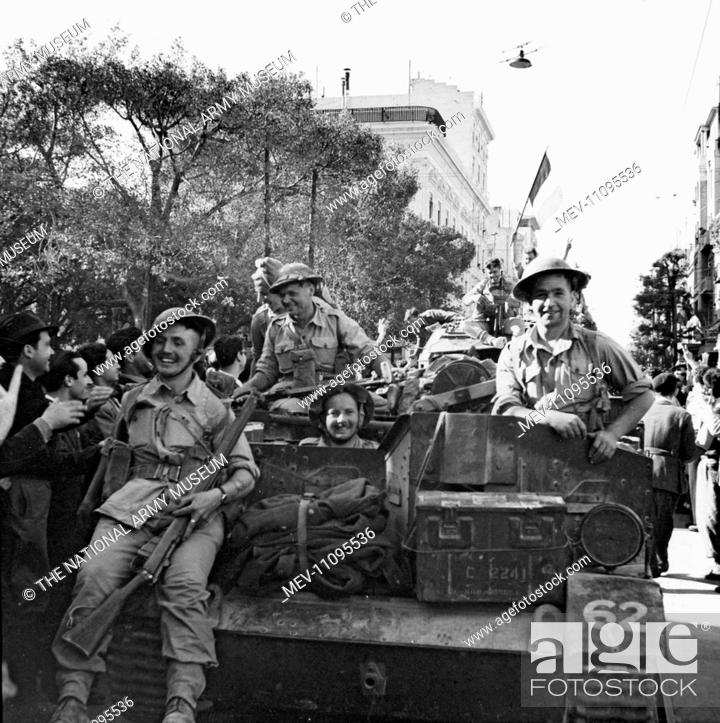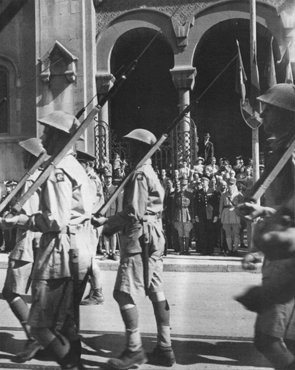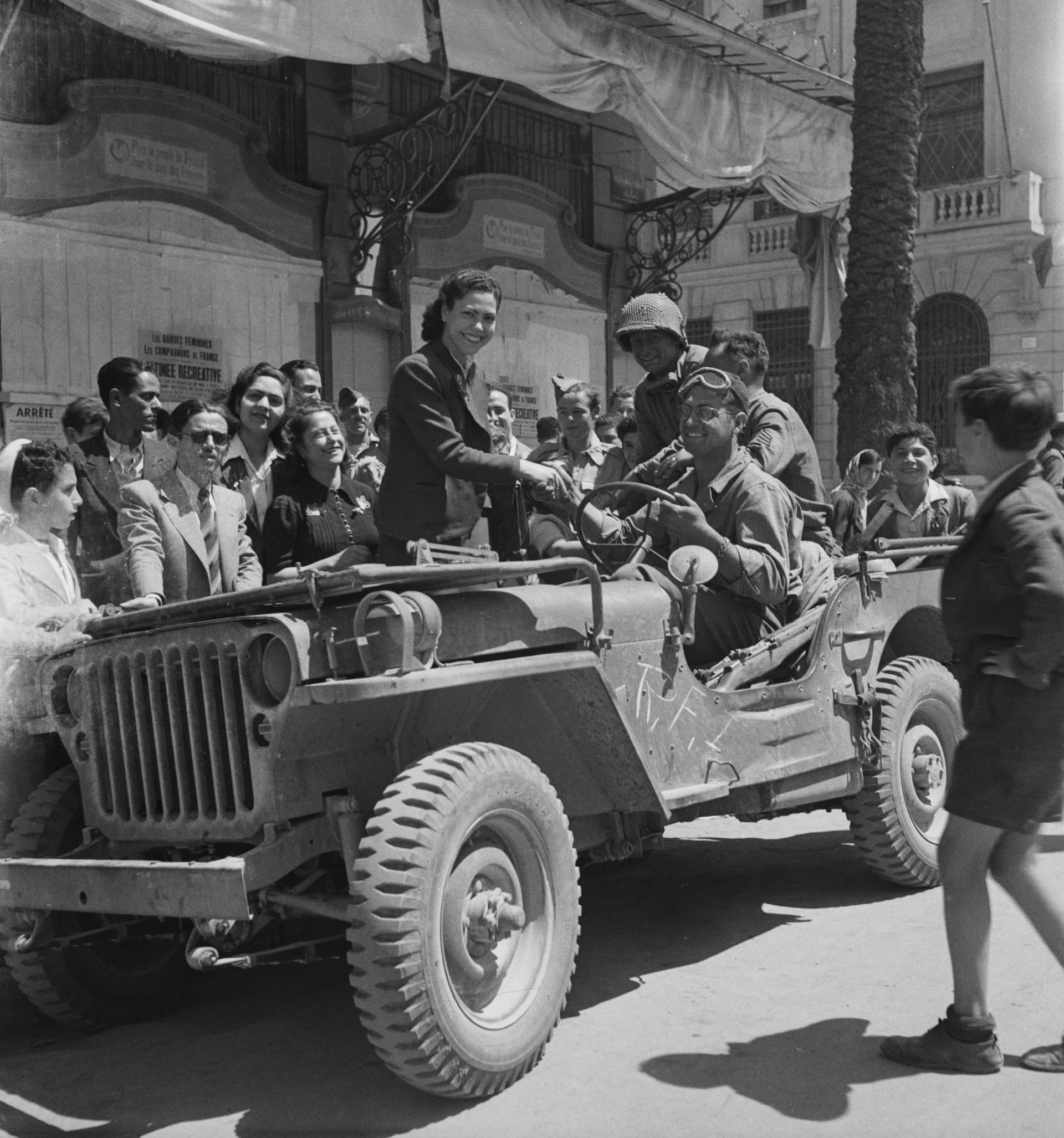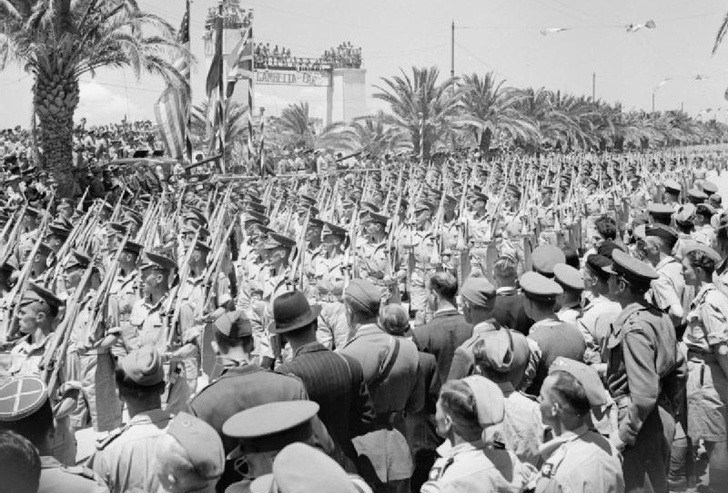Monty’s attempt to break through to Tunis had failed, but it made Kesselring and von Arnim believe they could be attacked in any sector along the front at any time. In this, they were quite correct, as they were about to find out. Crocker’s 9th Corps were the first to strike in the centre. At midnight on 22 April, two hundred guns opened up ahead of 46th British Division’s advance. The hills that barred the way to the Goubellat Plain were their immediate goal. The Leicesters were down to three of their usual four companies and were in reserve. While Peter Moore was comforted to know that the attack was being supported by such large numbers of artillery, he had come to learn that being in reserve was often an ominous situation. ‘It meant you were going to be hurled into action wherever a crisis arose and with very little preparation,’ he noted.
For two days they watched the battle as first British 6th Armoured, then 1st Armoured Divisions pushed through the plains either side of the high ground. On the 23rd, they moved up from their concentration area, following behind the tanks and preparing for any counter-attack. But none came, although it was clear their advance was not progressing as speedily as Crocker had hoped.
The Guards Brigade was also following behind 6th Armoured’s tanks, and once again Captain Nigel Nicolson was able to watch the armour press on across the open plain. At one point he noticed they all lurched forward then halted. A belch of thick smoke suddenly appeared from the turret of one of them – it had been hit by an 88 mm. ‘The other tanks then scurry around like a farm yard full of hens,’ wrote Nigel, ‘and try to get into position behind hills where the 88 cannot hit them, but they can hit the 88. All this is a very quiet affair. There is very little shooting, and the whole thing is very clumsy. Tank battles are not in the least bit slick.’ He then watched the infantry push forward and try and shoot at the 88 and its crew. The Germans then hurriedly brought up a half-track, hooked the 88 to the back of it and began withdrawing. This was the cue for the tanks to open fire again as their target scurried off. Then the armour pushed on forward again.
In this way, Crocker’s armour made slow and steady progress, but they had been unable to advance more than a few miles and there were still pockets of resistance on the high ground. On the 24th, the Leicesters, along with the Sherwood Foresters, were suddenly called upon to attack a cluster of hills known as the Djebel Bessioud. The plan was for the Leicesters to storm one ridge, the Forresters another.
To avoid a long march, the Leciesters were taken under the cover of darkness by recently arrived Churchill tanks, clinging desperately onto the flat area behind the turret and above the engine, as the tanks lurched and climbed to the start point. There they synchronized their watches and, staring into the darkness, waited on the grassy slopes for Z-Hour. On the stroke of midnight, the Leicesters and Sherwood Foresters stood up from where they’d been lying and began marching towards the German positions, which in the case of the Leicesters were just 800 yards away. They covered the first two hundred without any opposition, but then the Spandaus began drilling out their fire. Flares hissed into the sky, but so far Peter and the rest of ‘C’ Company, on the right flank of the hill, had not been seen. Their presence was not left undiscovered for long, however. Another flare burst above them, and machine-gun bullets crackled over their heads. Everyone dived for the ground, but once the flare died down they began to organize themselves for a final charge. One platoon was to give covering fire, while the other two pushed around to the right. Then a green flare was shot into the sky and all four companies charged at once. ‘As we charged, the Spandaus fell silent,’ noted Peter. ‘Even the splendid young men of the Hermann Göring Division had had enough.’ They took a handful of prisoners, but the rest had fled.
By dawn, the Foresters had also taken their hill. Peter Moore’s ‘C’ Company quickly set up their mortars but were out of range of the retreating enemy. The hill, however, gave the Leicestershire men a commanding view. Peter looked out across the wide sweep of the Goubellat Plain, with its tranquil-looking fields of corn and groves of fruit trees. Out of sight over the horizon was Tunis. At first glance, the path seemed tantalizingly clear, but appearances were deceptive. Crocker’s armour had forced 10th Panzer Division back some six miles but, if anything, German resistance here was stiffening rather than weakening, and there were still a number of hills that needed clearing, most particularly the Djebel Bou Kournine, known as the ‘Twin Tits’. American Mitchell bombers were called in to help, two waves of twenty-five. Peter was not envying the Germans, but then he watched in disbelief as the B-25s dropped their bombs on their own side. Once again it was the hapless Hampshires who bore the brunt; they had been jinxed throughout the campaign by incidents of friendly fire. As the Leicesters attended an Easter Sunday service in a grassy bowl on their captured high ground, Peter could sense the campaign was drawing to end. There would be one last effort, however. That night, Peter found himself marching across the dried salt lake then climbing up the precipitous Twin Tits, unsure of what they would find there, but expecting to meet German resistance at any moment. Miraculously, it was empty and the following day the Leicesters were withdrawn. It was to prove an unfortunate decision. Crocker’s drive had run out of steam, and in the lull the Twin Tits were reoccupied by the Germans, who wasted no time in fortifying them heavily. On 29 April, 2nd Rifle Brigade was given the task of storming the position at night. Although defended by only around thirty Germans, the bare and coverless slopes were now littered with mines, booby traps, and trip wires. Albert, manning a 6-pounder on the lower slopes, could only gaze at the black hulk of the mountain and try and work out what was going on. But all they could see was a mass of tracer, star shells briefly lighting a patch of the battle then fading, and bright, sudden, explosions as mines detonated or wires were tripped. But although the Riflemen were within shouting distance of the summit, they were unable to clear the final rock face. ‘We were a sombre group,’ noted Albert, ‘as we returned empty-handed to our positions.’
Over the hills to the north of 9th Corps, General Allfrey’s 5th Corps were preparing to launch their own two-pronged attack along the ridges of hills that overlooked the Medjerda Valley. On 20 April, Captain David Brown took the chance to write a long letter to his wife. He often fretted about money and was anxious that they should be trying to save something for the future. This was hard, he knew, but he urged her to try and manage. ‘We’ll have a super nest egg after the war is over,’ he wrote. ‘I look forward to it very much.’
He was tired. It had been a hectic few weeks – during the last stretch of fighting he’d gone seventy-two hours without sleep. Right now, he’d had enough of the Medjerda Valley, and especially of tramping up and down the mountains. ‘I’ve been a bloody mountain goat lately,’ he grumbled. The battery’s only means of transport to their gun positions on the high ground were pack mules, of which there never seemed to be enough. ‘You carry 60lb wireless sets, batteries, food, water and every damn thing up the mountain yourself,’ he wrote. ‘All this with no sleep and any little packets Jerry may be sending over.’ More than at any time since arriving in North Africa, David was feeling the tug of home; he wished he could be back in London, or anywhere in England, where spring would be bursting out once more. ‘Goodbye for now, darling,’ he finished off. ‘Much love to you and Carola, and your mum and pats to the wee chap, and regards to all.’ Then having added his regards to everyone else he could think of, he added, ‘And big hugs and kisses to you, my darling.’
The following day, the entire regiment moved up to new positions in preparation for 78th British Division’s attack on Longstop. ‘What a legend Longstop had become,’ wrote Alan Moorehead, who was there. He hoped to watch its capture. ‘For five months it had lain right in the front line, the fortress of the Medjerda Valley, the locked gate on the road to Tunis.’ As he climbed the hills before it and looked across at this stubborn crest, he likened it to ‘a great two-humped bulk that heaved itself out of the wheat fields like some fabulous whale beached on the edge of a green sea’.
During the night of 22 April, the 17th Field Artillery began firing concentrations onto the enemy positions on Longstop. Between them and the other divisional artillery they managed to bring 154 guns to bear, but despite their efforts the attacks the following morning met predictably stiff resistance. As troops and Churchill tanks began crawling up the slopes of Longstop on this sunny Good Friday, the battlefield soon became shrouded in smoke and dust and it was hard for anyone to follow quite what was going on. Alan Moorehead looked out and through the smoke watched Churchill tanks climbing unbelievably steep terrain ‘like toys’. Dot-like infantry scurried across the uplands while equally toy-like pack mules drudged up hill tracks.
David Brown was one of the dots that Alan was watching. Sent up ahead with the assaulting troops, he and several other gunners had been given the task of trying to establish a forward observation post. By early afternoon, despite intensive mortar and machine-gun fire, he had managed to reach the main summit along with the infantry of 36th Brigade. He got no further. Soon after, he was killed, his body discovered later during a lull in the fighting. David had been shot through the head.







